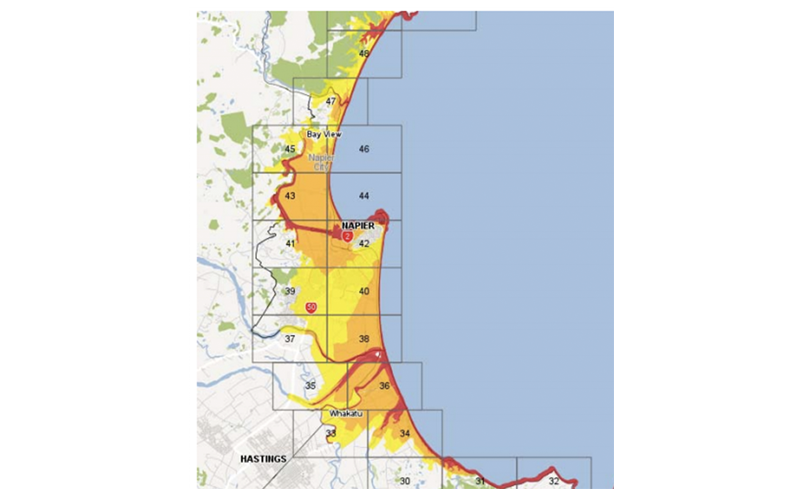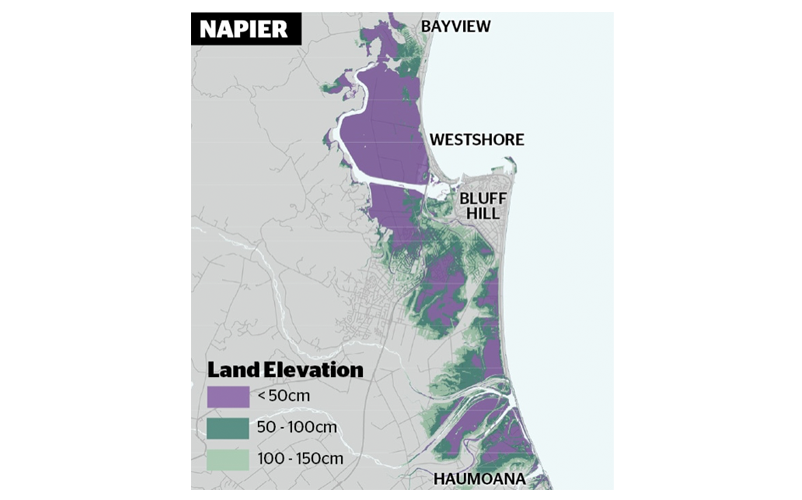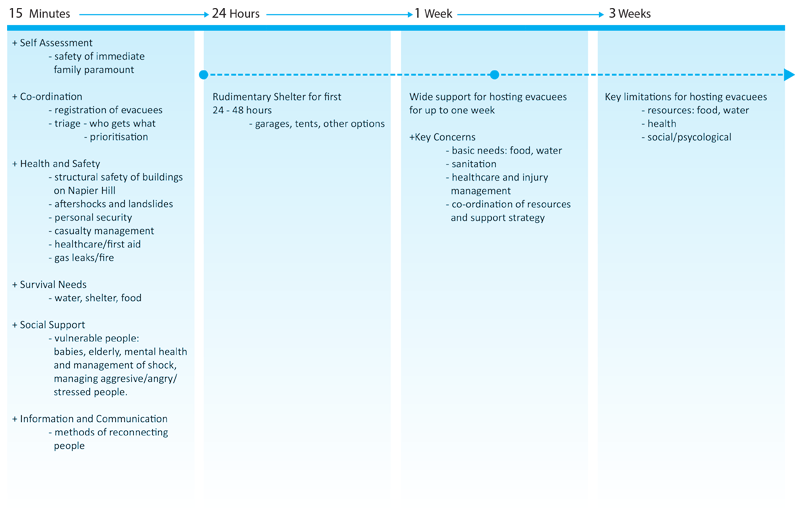The city of Napier is located on the east coast of New Zealand’s North Island and is vulnerable to earthquake and tsunami. In the event of a tsunami, people need to evacuate inland or to higher ground. Napier Hill is the only high ground in close proximity to Napier and up to 12,000 people would have to evacuate there within 20 minutes of a tsunami warning. This study worked with residents on Napier Hill to understand their willingness and capacity to support evacuees in such a scenario. Focus groups were held with a sample of residents in July 2019 and this was followed by a survey. Analysis showed that residents were generally happy to host evacuees and offer support if they could. However, individual support efforts would likely only be sufficient for the first few days. Long-term success in evacuee support would require strategic thinking and collaborative planning between emergency management agencies and local neighbourhood groups.
Introduction
Offshore to the east of the North Island of New Zealand lies the Hikurangi subduction zone and many crustal faults capable of producing damaging tsunami (Clark et al. 2019). Consequently, New Zealand’s east coast is vulnerable to tsunami due to its proximity to the Hikurangi subduction zone. Napier is a major city in this region with a population of around 66,000. It is a low-lying, agricultural area and most people live within identified tsunami evacuation zones (Figure 1) and on low-lying land (Figure 2). The surrounding topography does not provide high ground for easy on-foot evacuation and the few very tall buildings able to withstand tsunami inundation make mass evacuation there untenable (MCDEM 2018).
Figure 1 shows the immediate coastal area of Hawke’s Bay with Napier on the coast. The coloured zones represent the maximum area to evacuate should a large tsunami be generated close to New Zealand. Areas of red show the Red Zone. This is the most immediate evacuation zone (including the beach, foreshore and marine environment), which should be evacuated in any tsunami threat to the Hawke’s Bay coastline. The Orange Zone (plus the Red Zone) is evacuated if there is a major threat from a distant-source tsunami and near-source tsunami risk. The Yellow Zone (as well as Red and Orange zones) should be self-evacuated if a long or strong earthquake has been felt. This zone system provides a trigger mechanism for officials and also informs residents of their location in relation to tsunami risk.

Figure 1: Modelling shows the tsunami inundation risk zones around Napier and extending into low-lying areas.
Source: Hawke’s Bay Regional Council and Hawke’s Bay Civil Defence Emergency Management Group
Figure 2 shows that land elevations from the coastline to 1.5 metres above sea level are particularly exposed to tsunami risk, as even small-sized tsunamis can inundate these areas.

Figure 2: Land elevations around Napier show that elevations below 1.5 metres are particularly exposed to tsunami risk.
Source: Sharpe 2015
Napier Hill, which comprises Bluff Hill and Hospital Hill, is the only area of ‘tsunami safe’ ground immediately adjacent to the city. This is the primary evacuation destination for up to approximately 12,000 people who could evacuate on foot to Napier Hill within 20 minutes of an earthquake warning (Power et al. 2019). When Napier Hill residents and evacuees are combined, it is possible that approximately 15,000–20,000 people could retreat to Napier Hill. Evacuees would be distressed, separated from families and their loved ones and some could be badly injured (Hawke’s Bay CDEM 2019, Malone et al. 2011). They would likely be carrying very few resources to survive the following days. A scenario-based method was applied to examine the capacity for supporting evacuees on Napier Hill. Such an influx puts strain on the local Napier Hill community as well as local infrastructure and services.
Method
This study used three focus groups and a public survey with Napier Hill residents in July 2019 to understand their perspectives on supporting evacuees. Each focus group had between 19 and 22 people and sessions ran for 1.5 hours using a scenario-based outline. The scenario was based on a credible magnitude 8.9 earthquake and tsunami from the Hikurangi subduction zone (as outlined in Power et al. 2018). Participants could reflect on the scenario and discuss their priorities and how they could support evacuees. A mapping exercise was used where participants could identify strategically valuable locations on Napier Hill.
A follow-up email was sent to participants that linked to a six-question survey of predominantly free-response questions about how residents might respond to and support evacuees. Participants were encouraged to share the survey and to ask other people (e.g. neighbours and friends) on Napier Hill to participate (N=68). Data from the focus groups and the survey were analysed using qualitative thematic analysis (Rubin & Rubin 2011).
This research followed Massey University Human Ethics processes (low risk notification number: 4000021400).
Findings
Discussions from the focus groups revealed that participants supported hosting evacuees and offering assistance, similar to the support experienced by residents of Christchurch after the earthquakes of 2010 and 2011 (Burton et al. 2015). Participants initially indicated that they would be willing to host people for ‘as long as possible’. However, after reflection, changed this to ‘as long as we have resources’ (as expressed by Female Resident 6, Focus Group 2). Participants also identified various issues related to hosting evacuees. These are summarised in Table 1.
gathered from the follow-up survey supported focus group findings. However, there was a difference in terms of the broadness of community outlook. In the focus groups, participants came together to discuss issues in a cooperative, solution-focused way, which often highlighted connections and responsibilities for others. In comparison, the survey generally elicited self- or family-focused responses. This aligns with the findings of Sim (2001) who concluded that ‘focus groups explore collective, not individual phenomenology’ (p.351).
Table 1: Summary of issues related to hosting evacuees as identified by focus group participants.
| Issues | Potential issues |
| Evacuation process issues |
|
| Hosting evacuees |
|
| Meeting the needs of evacuees |
|
| Information and communication issues |
|
| Need for planning |
|
Response timeframes
An overview of participant concerns across an estimated three-week response timeframe is provided in Figure 3.
Initial response: day 1
The initial response of residents was empathetic and concerns were focused on the wellbeing of themselves, their families and evacuees. Many participants identified the need to provide evacuees with support and basic needs (i.e. first aid, fresh water, food, accommodation). Across all focus groups, participants identified the need for a pre-planned and coordinated approach to register evacuees so that there was a record of who they were and where they would be located on Napier Hill.
Participants identified the need to pool resources as a community and come together to support evacuees. Overall, most participants and survey respondents indicated their willingness to provide shelter and to support evacuees within the limits of their resources. For example, one person (Female Resident 9, Focus Group 2) suggested that they would be ‘…willing to support evacuees until the food runs out’. Retirees and pensioners who attended the focus groups stated concerns for their personal safety and indicated that what they could offer to others was limited (i.e. limited supplies due to affordability). For other participants, they were focused on supporting their family unit and they saw it as a government responsibility to provide wider support. Focus group discussions indicated that there was not a community shared expectation for providing support to evacuees. In addition, any response to offer support to evacuees would currently be ad hoc and would rely on the generosity of individuals.
Longer-term response: week 1
During focus group discussions, participants determined they could host varying numbers of evacuees in a basic way for three days and up to one week. But if this period were to be extended to three weeks, there would be significant challenges. To clarify, participants were comfortable to host evacuees for up to 48 hours but, for longer periods, were concerned about how they would support their own needs alongside those of evacuees given current levels of preparedness.
Figure 4 shows that the concerns participants expressed about hosting evacuees over extended timeframes related to providing basic needs like health care and injury management as well as social-psychological support. Participants also highlighted the need for a coordinated approach. It was considered a major task to coordinate people and limited resources. Participants suggested that existing Napier Hill groups or leaders could develop such a strategy and existing neighbourhood support groups were specifically mentioned. Both the Hawke’s Bay CDEM Group and Napier City Council were supportive of such collaborative development and co-design of planning processes with residents to improve effective management of future evacuees.

Figure 3: Initial response timeframes and correlated critical needs identified in focus group discussions.
Discussion
Community-led risk reduction
The findings show that collaborative scenarios can catalyse agencies working with communities on complex, multi-scale response planning issues (Davies et al. 2015; Whittaker, McLennan & Handmer 2015). Paton and colleagues (2017) note that community-based planning is often a desired outcome in response planning. However, achieving community buy-in and community-led outcomes is often met by obstacles independent of the hazard context. For examples see case studies in earthquake and tsunami preparedness and planning by Vallance (2013)) and in the Australian and Californian bushfire contexts.
In line with key principles of community engagement (Whittaker, McLennan & Handmer 2015; Wells et al. 2013; Becker et al. 2013), this study demonstrated the value of creating a space for solutions-focused dialogue and collaboration with communities. Whittaker, McLennan and Handmer (2015) emphasise:
…given the increasing disaster risk worldwide due to population growth, urban development and climate change, it is likely that ‘informal’ volunteers will provide much of the additional surge capacity required to respond to more frequent emergencies and disasters in the future.
(Whittaker, McLennan & Handmer 2015, p.358)
Therefore, supporting the development of collective capacity within local communities is critically important, because:
…ordinary citizens who volunteer their time, knowledge, skills and resources to help others in times of crisis represent an immense resource for emergency and disaster management.
(Whittaker, McLennan & Handmer 2015, p.366)
Leading community members through a scenario was effective for focused engagement and rapidly captured participant attention due to the enormity of the potential scenario. However, it was important to facilitate the sessions towards focused discussions and practical solutions for effective outcomes (McIvor & Paton 2007, Paton et al. 2006). Laminated maps of Napier Hill were used to assist discussions, encourage engagement and maintain focus in exercises like participatory mapping (Cadag & Gaillard 2012).
Planning
Effective planning prior to an event was a key priority raised by all focus group and survey responses. This reiterates literature insight (Whittaker et al. 2020). Participants indicated that planning was required at multiple levels, from personal planning through to community-based planning and upskilling. Many participants emphasised that existing Neighbourhood Support2 groups could play a significant role in evacuation planning and response coordination. Research into community experiences following the 2011 Christchurch and 2016 Kaikōura earthquakes supports this finding and emphasise the importance of local responses (Carter & Kenney 2018, Kenney & Phibbs 2015, Paton, Mamula-Seadon & Selway 2013) including neighbourhood groups (Stallard 2013) in responding rapidly. It follows that localised community leadership and planning should be pursued and supported by relevant agencies (Kwok et al. 2018; Becker, McBride & Paton 2013).
This research highlighted a range of benefits for empowering and bolstering existing networks:
- Community leadership is essential and local leaders generally know their communities better than response agency employees.
- Local groups make it easy to identify important skillsets in the community (e.g. several doctors and other healthcare professionals live on Napier Hill).
- Grassroots strategies are more readily supported locally, compared to strategies that are proposed or imposed by ‘outside’ agencies.
There is the potential to train community members in a way that builds capacity to share responsibilities when an event occurs. Decentralisation spreads the workload, but trust between agencies and local groups is required.
Decentralising some responsibilities that currently sit with response agencies that enables community leaders to buy-in and bring about change at the local level would be beneficial. Participants considered that localised response planning and relationship building would achieve better outcomes that are influenced less by local agencies.
These benefits encourage emergency management practitioners and managers to rethink the decentralisation of responsibilities from an empowerment perspective. It could be a controlled process of empowering people to think and behave differently and become better prepared for disruptive events.
Taking responsibility
In New Zealand, the Civil Defence and Emergency Management (CDEM) response and planning was traditionally aligned with top-down approaches administered by emergency services and the New Zealand Defence Force. However, CDEM functions under the Civil Defence and Emergency Management Act 2002 indicate that decentralisation is a core government objective (Mamula-Seadon & McLean 2015). At a regional level, this decentralisation has occurred with varied success and CDEM functions remain, to a large degree, expert and agency-led rather than driven by communities.

In May 1960, Napier experienced a tsunami that inundated much of the boat harbour.
Image: Russell Spiller (reproduced with permission)
The decentralisation responsibilities and ‘sharing the workload’ in an event were common themes raised in the focus groups. In particular, although the terminology and concept of a community ‘hub’ is not currently used in material produced by agencies in Hawke’s Bay, focus group participants discussed this concept. In several examples, participants suggested that existing Neighbourhood Support groups could be activated and become ‘response groups or hubs’. Currently, some Neighbourhood Support groups on Napier Hill are more active than others so the introduction of greater planning for major events could re-invigorate less-active groups.
Using local capacity is well supported by New Zealand Civil Defence. However, resourcing and bolstering existing groups and networks, while often context specific, remains under-researched. Aligned with Whittaker, McLennan and Handmer (2020), locally grounded research provides better understanding of the complexity of community dynamics and needs. These can include:
- community context (i.e. the socio-demographic characteristics of a community)
- community perceptions of risk, including awareness and attitudes towards risk reduction activities
- the information and sources communities are using to plan and prepare
- community expectations regarding warnings, information and centralised support
- communication needs.
When considering the mobilisation of community-based planning, Neighbourhood Support groups are recognised by, and often well connected to, diverse subsets of communities. This means they could function effectively as links to such groups in agency-led response planning and bring valuable community insight and resources. They could also broker buy-in from other sections of communities to enhance knowledge, social capital and empowerment (Izadkhah & Hosseini 2010). In other countries, neighbourhood networks have been effective in response and recovery situations (e.g. Fisker-Nielsen 2010, Mavrodieva et al. 2019). This offers practical proof of the efficacy of Neighbourhood Support groups.
Conclusion
This study used focus groups and a follow-up survey of residents on Napier Hill to gather their perspectives and capacity to support a significant evacuation from the city of Napier should a tsunami strike the coast. As might be expected, the initial response of participants was for collaboration and a willingness to support evacuees in the immediate term. However, for periods of three weeks or greater, participants recognised issues that could impede their capacity to offer ongoing support and the value of that support to evacuees. There is strong evidence that community-led risk reduction planning involves more community members, identifies local needs and abilities and critical enabling resources and prepares communities better for disaster events. New Zealand’s structure of Neighbourhood Support groups offers great potential to take on more responsibility for risk identification, emergency planning and response and recovery planning.


